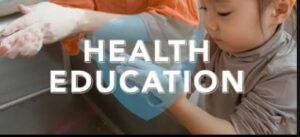Srijan Class-9 Aids to Health ICSE Biology Solutions Ch-16. We Provide Solutions of Concept Check 1 to 4, Very Short Ans, Short Ans, Long Ans, Multiple Choice Type Application / Skill ( Figure Based ) Questions by expert teachers as per ICSE board guidelines. Visit official Website CISCE for detail information about ICSE Board Class-9.
Solutions of Srijan Class-9 Aids to Health ICSE Biology Ch-16

| Board | ICSE |
| Publications | Srijan Publication |
| Subject | Biology |
| Class | 9th |
| writer | Veer Bala Rastogi |
| Chapter-16 | Aids to Health |
| Topics | Solutions of Concept Check 1 to 4, Very Short Ans, Short Ans, Long Ans, MCQ, Application Skill Based Questions |
| Edition | 2021-2022 |
Concept Check 1 (Page 186)
(Ch-16 Aids to Health Srijan ICSE Class-9 Biology Solutions )
Give one example of each of the following.
1. Mechanical barrier that prevents entry of germs into the body.
2 Chemical secreted by the stomach that kills the germs.
3. Germ-killing body secretion.
4. Germ-trapping body secretion.
5. A chemical released by the damaged tissue cells.
Answer:
1. Mucus
2. Hydrochloric acid
3. Saliva
4. Sebum
5. Interferons
Concept Check 2 (Page 189)
(Ch-16 Aids to Health Srijan ICSE Class-9 Biology Solutions )
A. Answer the following questions.
Q-1. Give three routes of the entry of pathogens in the body.
Answer : direct physical contact by touching an infected person. direct physical contact (usually by touching soil contamination or a contaminated surface) airborne transmission (if the microorganism can remain in the air for long periods) fecal-oral transmission (usually from contaminated food or water sources)
Q-2. Name the process by which WBCs Squeeze out of the walls of blood capillaries.
Answer:-The process of WBCs squeezing out through the walls of the blood capillaries is called diapedesis. Explanation: Most WBC’s are amoeboid in nature and can produce pseudopodia with which they can squeeze out of the walls of the capillaries into the tissue known as diapedesis.
Q-3. Name large amoeboid cells located in tissues.
Answer:-A macrophage is a type of phagocyte, which is a cell responsible for detecting, engulfing and destroying pathogens and apoptotic cells
Q-4. What is the result of Swelling and tissue destruction?
Answer:–The function of inflammation is to eliminate the initial cause of cell injury, clear out necrotic cells and tissues damaged from the original insult
Q-5. Name the mechanical barrier that prevents entry of germs.
Answer:- Mechanical barriers physically block pathogens from entering the body. The skin is the most important mechanical barrier. In fact, it is the single most important defense the body has. The outer layer of the skin is tough and very difficult for pathogens to penetrate.
Q-6. Name the germ-trapping body secretion.
Answer:–The three germ killing secretions of our body are:
(i) Mucus secretions from windpipe
(ii) Hydrochloric secretions from stomach
(iii) Tears from eyes.
B. State whether the following statements are true or false. If false, write the correct statement by changing the incorrect word/words only.
1. One kind of antibodies act against only one kind of pathogens.
2. Our body produces antigens to fight against antibodies.
3. Body’s local defense system uses mostly physical and chemical barriers against pathogens.
4. Vaccination helps in acquiring active immunity artificially.
Answer:
1. True
2. False
3. True
4. True
C. Fill in the blanks with suitable words.
1. Mother’s antibodies usually reach the foetus through ……………
2. Antibodies eat up the …………..
3. Our body produces ………………. to fight against ……………
4. Human beings can suffer from all those diseases which attack ………….. and ……………
Answer:
1. Placenta
2. Germs
3. Antibodies, Antigen
4.Animal , Plant
Concept Check 3 (Page 194)
(Ch-16 Aids to Health Srijan ICSE Class-9 Biology Solutions )
Fill in the blanks.
1. Vaccines provide …………. immunity to the body.
2. Vaccines of tetanus and diphtheria are produced using …………
3. The third booster dose of DPT is given at ………………. weeks after birth.
4. Antibiotics are obtained from ……………. and ………….
5. ……………… are applied on skin at the site of injury.
6. ……………… are used to kill germs at hospitals, bathroom, etc.
Answer:
1. Active
2. Toxoids
3. 14
4. Bacteria, Yeasts
5. Antiseptics
6. Disinfectants
Concept Check 4 (Page 196)
(Ch-16 Aids to Health Srijan ICSE Class-9 Biology Solutions )
Answer the following questions.
1. Where are the headquarters of WHO located?
2 In which year was Indian Red Cross Society established?
3. Who was responsible for the formation of Red Cross Society?
Answer:
1 Geneva, Switzerland
2. 1920
3. Henry Dunant
A. VERY SHORT ANSWER TYPE, (Page 197)
(Ch-16 Aids to Health Srijan ICSE Class-9 Biology Solutions )
Q-1. Define the following terms
(a) Vaccination
Answer:–The act of introducing a vaccine into the body to produce protection from a specific disease. Immunization: A process by which a person becomes protected against a disease through vaccination. This term is often used interchangeably with vaccination or inoculation.
(b) Antiseptic
Answer:– Antiseptics are the drugs which are used to kill or to prevent the growth of micro-organism, applied externally on living tissues
(c) Disinfectant
Answer:–A disinfectant is a chemical substance or compound used to inactivate or destroy microorganisms on inert surfaces. … Disinfectants can also be used to destroy microorganisms on the skin and mucous membrane, as in the medical dictionary historically the word simply meant that it destroys microbes.
(d) Antibiotic
Answer:–A drug used to treat bacterial infections. Antibiotics have no effect on viral infections. Originally, an antibiotic was a substance produced by one microorganism that selectively inhibits the growth of another.
Q-2. Name the following.
(a) The process by which white blood cells engulf harmful microbes.
(b) The microorganism that causes AlDS.
(c) Any three germ-killing secretions of our body.
(d) Mild chemical applied on the skin to kill germs.
(e) Chemical substance obtained from certain microorganism that destroys harmful microbes.
(f) Extracts of toxins secreted by bacteria.
(g) A foreign body that induces the formation of antibodies in the body.
(h) An organization that looks after maternity and child welfare centers.
Answer:
(a) Phagocytosis
(b) Human Immunodeficiency virus.
(c) Salivc, Tears, sweat.
(d) Antiseptics
(e) Antibiotics
(f) Exotoxins
(g) Antigen
(h) Red cross
Q-3. Write the full forms of the following vaccines and mention the purpose for which they are produced.
(a) TT Vaccine
(b) MMR Vaccine
(c) DT Vaccine
(d) BCG Vaccine
(e) DPT Vaccine
Answer:
(a) Tetanus Toxoid Vaccine, Against Tetanus
(b) Measles, Mumps and Rubella Vaccine, Protection against Measles.
(c) Diphtheria and Tetanus Vaccine, Protection against Diphtheria and Tetanus
(d) Bacille Calmette-Guerin Vaccine, For Tuberculosis
(e) Diphtheria, Tetanus and Pertussis Vaccine, Protection against Diphtheria, Pertussis, and Tetanus
Q-4. State whether the following statements are true or false.
(a) Body’s first line of defence against pathogens contains Iymphocytes.
(b) DPT is a vaccine for diphtheria, whooping cough and typhoid.
(c) MMR vaccine protects against measles, mumps and rubella.
(d) Salk vaccine is used against tuberculosis.
(e) Chemicals applied to spots and places to kill harmful microorganism are called disinfectants.
(f) Alexender Fleming coined the term antibiotic for substances like penicillin.
(g) Penicillin obtained from a fungus is an example of an antibody
Answer:
(a) False
(b) False
(c) True
(d) False
(e) True
(f) True
(g) True
B. Short Answer Type Questions (Page 197)
(Ch-16 Aids to Health Srijan ICSE Class-9 Biology Solutions )
Q-1. Answer the following questions.
(a) What are body’s own lines of defense?
Answer:-The human body has three primary lines of defense to fight against foreign invaders, including viruses, bacteria, and fungi. The immune system’s three lines of defense include physical and chemical barriers, non-specific innate responses, and specific adaptive responses
(b) Explain the use and action of the following:
(i) Antiseptics
Answer-Antiseptics are substances that help to stop the growth of microorganisms on the skin. They’re used daily in medical settings to reduce the risk of infection and stop the spread of germs. While they’re generally safe, it’s best to avoid using them for long periods of time.
(ii) Vaccine
Answer:–Vaccines train your immune system to create antibodies, just as it does when it’s exposed to a disease. However, because vaccines contain only killed or weakened forms of germs like viruses or bacteria, they do not cause the disease or put you at risk of its complications
(c) List any three responsibilities of local bodies in caring for people’s health.
Answer:–The areas of public health responsibility include (1) assuring an adequate local public health infrastructure, (2) promoting healthy communities and healthy behaviors, (3) preventing the spread of communicable disease, (4) protecting against environmental health hazards, (5) preparing for and responding to emergencies
(d) Name any two programmed being run by Indian government for solving the health problems in India.
Answer:
- Janani Suraksha Yojana.
- Pradhan Mantri Swasthya Suraksha Yojana (PMSSY)
- National Viral Hepatitis Surveillance Programme.
- National Programme for the Health Care for the Elderly.
(e) Mention any three functions of the Red Cross.
Answer:–Three Functions of Red Cross: (1) To extend relief and help to the victims of any calamity such as flood, fire, famine and earthquake etc. (2) To produce and supply blood for the needy victims of war or other calamities. (3) To extend all possible first aid in any accident
(f) The organisation that suggests quarantine measures to prevent the spread of diseases.
Answer:- WHO
(g) Mention three functions of WHO.
Answer:– Important Functions of the World Health Organization
- Providing Leadership on Global Health. …
- Shaping the Research Agenda. …
- Setting the Standards for Global Health. …
- Advocating for Evidence-Based and Ethical Policy. …
- Monitoring and Assessing Health Trends and Concerns.
Q-2. Differentiate between the following.
(a) Innate immunity and acquired immunity
Answer:– Innate immunity is the inborn resistance against infections that an individual possesses right from birth, due to his genetic or constitutional markup. Acquired immunity is the resistance against infecting foreign substances that an individual acquires or adapts during the course of life.
(b) Active immunity and passive immunity
Answer:
| Active Immunity | Passive Immunity |
| Active immunity is usually permanent – it is produced by the antibodies of the host in response to direct contact of an antigen | Passive immunity lasts only for a few weeks or months. It is produced by the introduction of antibodies from outside to the host |
| It produces an immunological memory | It does not produce immunological memory |
| When the antigens enter the body, antibodies and other specialised lymphocytes are produced | Antibodies are introduced from an external source. For instance, a mother introduces antibodies to a fetus through the placenta and to an infant via mother’s milk. |
| There are no side-effects | It may cause reactions |
| Immunity does not occur immediately | Immunity develops immediately |
(c) Serum and vaccine
Answer:– Vaccines stimulate the body to produce its own immunity to a specific disease, but serum therapy takes disease-fighting chemicals (antibodies) from the blood of recovered patients and transfers them to the sick to boost their defenses
(d) DPT and BCG (Expanded form of the vaccine)
Answer:–DPT – Diphtheria Pertussis Tetanus, it is also referred to as DTP and is the name of a vaccine against the three named diseases. BCG – Bacillus Calmette–Guérin is a popular vaccine used to counter tuberculosis or leprosy. .
(e) Disinfectant and antiseptic
Answer:– Disinfectants are used to kill germs on nonliving surfaces. Antiseptics kill microorganisms on your skin
C. Long Answer Type Questions (Page 198)
(Ch-16 Aids to Health Srijan ICSE Class-9 Biology Solutions )
Q-1. What are physical barries? How do they prevent infection?
Answer: The skin, mucous membranes, and endothelia throughout the body serve as physical barriers that prevent microbes from reaching potential sites of infection.
Q-2. What does second line of defense include? How does it save the body from infection?
Answer:– The second line of defense is nonspecific resistance that destroys invaders in a generalized way without targeting specific individuals: Phagocytic cells ingest and destroy all microbes that pass into body tissues. For example macrophages are cells derived from monocytes (a type of white blood cell).
Q-3. What are antibiotics? List their characteristics.
Answer:-
Antibiotics are antimicrobial drugs obtained from other organisms (such as moulds, fungus and some soil bacteria) to combat harmful microorganisms. However, they are not very useful against certain microbes such as viruses.
Antibiotics are produced on a large scale by the fermentation process. This is a chemical process which is induced by the microorganisms in a large tank. A large tank contains the growth medium that provides nutrition for the microorganism’s growth. Optimization of temperature, pH levels, oxygen and nutrient parameter in the fermentation tank is very crucial to produce antibiotics. After the completion of antibiotics production, they are extracted and purified through multiple physical processes. Finally, the purified antibiotics are converted into crystal form.
Q-4. What are different kinds of vaccines? Describe with examples.
Answer:-
Definition
The process of implementing the vaccine is called vaccination. It is responsible for the clearance of many diseases, especially infectious diseases like smallpox and chickenpox. The word “vaccine” is derived from the Latin word “vaccines” which means “from the cows”.
Invention of Vaccine
The practice of immunization of the body dates back hundreds of years, but the first official vaccination was developed by Edward Jenner who is considered the founder of vaccinology. In 1796, he injected a 13 year-old-boy with cowpox(vaccinia virus) and established immunity to smallpox. In 1798, the very first smallpox was developed. During the 18th and 19th centuries, systematic implementation of mass smallpox immunization culminated in its global establishment in 1979.
Types of Vaccines
There are many initiations to vaccine development, but vaccines can be mainly classified by how the antigen, active component, that produce a specific immune response against the disease-causing organism, are prepared.
Classification of Vaccines
A. Live Attenuated Vaccines:
Attenuated vaccines are developed in many several ways. The common methods include passing the disease-causing virus through a series of cell cultures or animal embryos. When the vaccine virus is implemented in a human, it will be unable to replicate enough to cause illness, but still promotes an immune response that can protect against future infection.
B. Inactivated Vaccine:
Vaccines of this category are developed by inactivating a pathogen, typically using chemicals or even heat such as formaldehyde or formalin. This destroys the pathogen’s ability to replicate but keeps it intact so that the immune still remembers it.
C. Toxoid Vaccine:
There are some bacterial diseases that are not directly caused by a bacteria itself, but by producing toxins by the bacterium. For this type, immunization of pathogens can be developed by inactivating the toxin that causes disease symptoms. As the viruses or organisms used to kill or inactivate vaccines, this can be done through treatment with a chemical such as formalin or by heat.
D. Subunit Vaccine:
Subunit vaccines are only used as part of a target pathogen to promote a response from the immune system. This can be done by isolating a specific protein from a pathogen and presenting it as an antigen on its own.
E. Conjugate Vaccine:
Conjugate vaccines are somehow similar to recombinant vaccines, they are made up of a combination of two different components. Conjugate vaccines, however, are made up of using the pieces from the coat of bacteria. These coats are chemically linked to a carrier immune protein, and this is how a combinational vaccine is used.
F. Valence Vaccine:
Vaccines may be monovalent. The monovalent vaccine is designed to be immune against a single microorganism or single antigen. A multivalent or polyvalent vaccine is made to immunize against two or more viruses of the same microorganism.
G. Heterotypic Vaccine:
Heterologous vaccines are also called “jennerian vaccines”. These vaccines are pathogens of different animals that either do not cause disease or cause disease or cause mild disease in the organism being treated.
D. Multiple Choice Questions (Page 198)
(Ch-16 Aids to Health Srijan ICSE Class-9 Biology Solutions )
Choose the correct answer.
Q-1. Antivenin against snake poison contains
(a) Antigens
(b) Antigen-antibody complex
(c) Antibodies
(d) Enzymes
Answer: (c) Antibodies
Q-2. The cells affected in AlDS are
(a) T- lymphocytes
(b) B-lymphocytes
(c)RBCs
(d) Neutrophils
Answer: (a) T- lymphocytes
Q-3. Interferons are produced by
(a) Bacteria-infected cells
(b) Virus-infected cells
(c) Cell metabolism
(d) WBCs
Answer: (b) Virus-infected cells
Q-4. The organization which supplies blood for victims of war is
(a) WHO
(b) Red Red Cross Society
(c) Both (a) and (6)
(d) None of these
Answer: (b) Red Red Cross Society
E Application /Skill-based Questions (Page 198)
(Ch-16 Aids to Health Srijan ICSE Class-9 Biology Solutions )
Q-Given below are incomplete explanations of certain biological processes / terms where a key word has been left out. Rewrite the complete explanation by inserting the key word in the space indicated by ‘ˆ’.
(a) Vaccine is a preparation consisting of ‘ˆ ‘microbes which help to build immunity in the human body.
(b) Antiseptics are chemical substances applied to the ‘ˆ’ to destroy or prevent the growth and multiplication of harmful microbes.
Ans:
(a) Vaccine is a preparation consisting of ‘dead or weakenedˆ ‘microbes which help to build immunity in the human body.
(b) Antiseptics are chemical substances applied to the ‘ˆskin of living‘ to destroy or prevent the growth and multiplication of harmful microbes.
Thanks



In A. Very Short Answer type question q4 true/ fase 6. Penicillin is not an example of antibody, it is an example of antibiotics.
A . 4. 6. Penicillin is not an example of the antibody, it is antibiotics